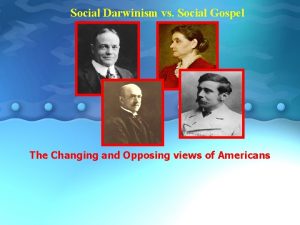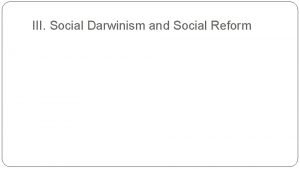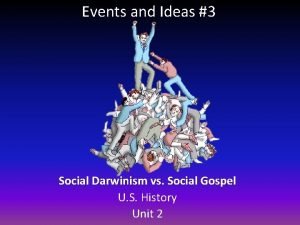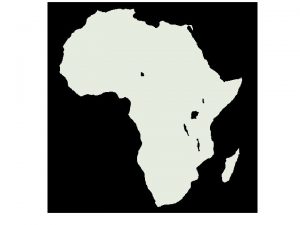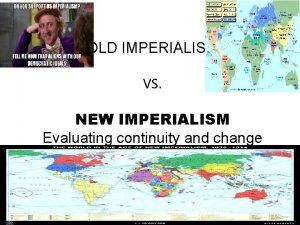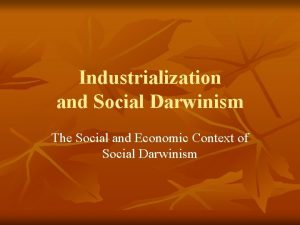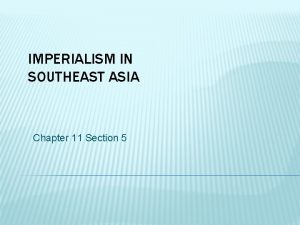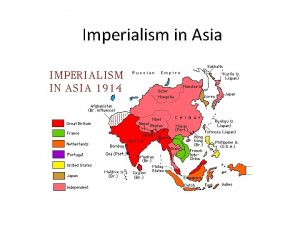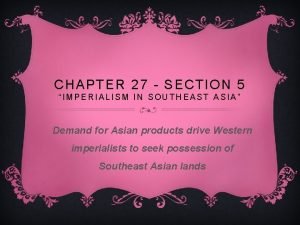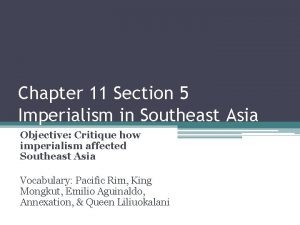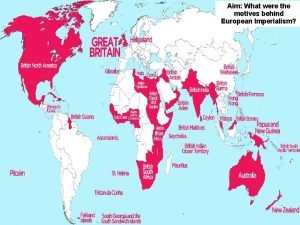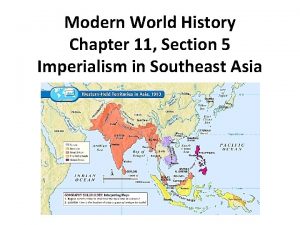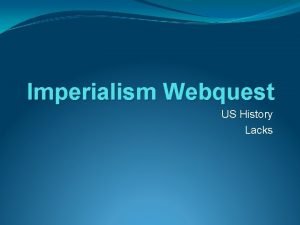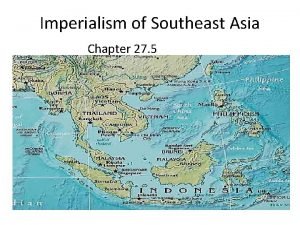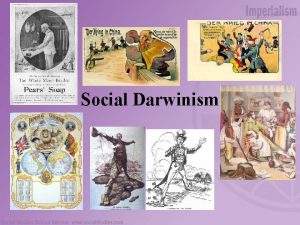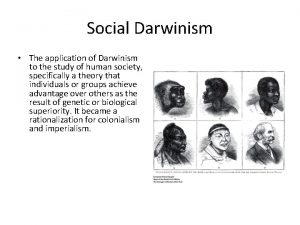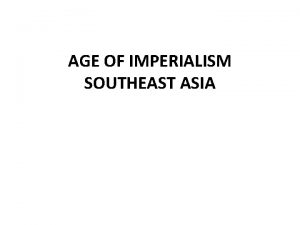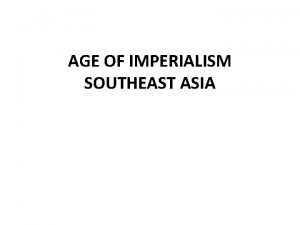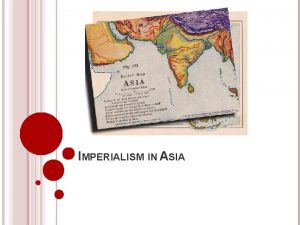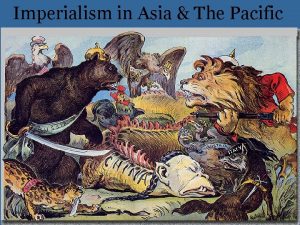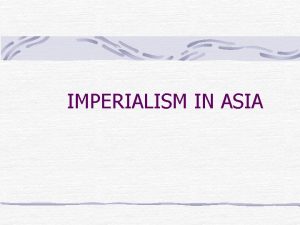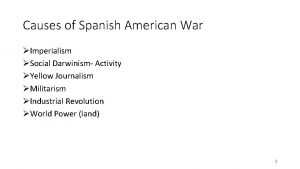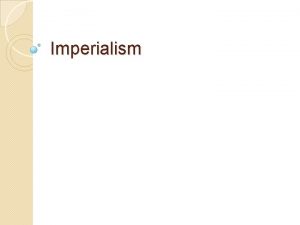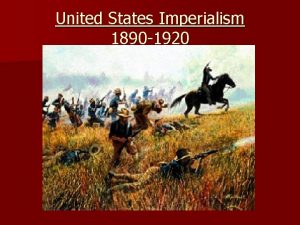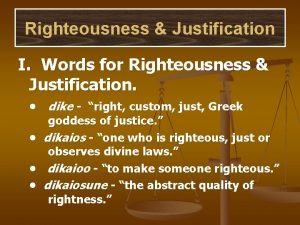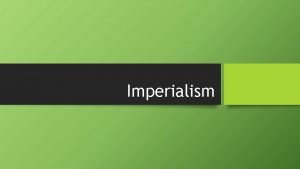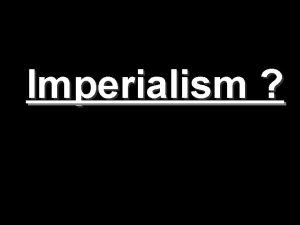Imperialism in Asia A Justification 1 Social Darwinism





















- Slides: 21

Imperialism in Asia

A. Justification 1. Social Darwinism, which applied Darwin’s theory of natural selection to sociology a. Dominant classes or races rose to the top b. Because Britain was the most powerful nation the British were superior 2. Second … not only were the British superior they had a moral obligation to dominate and civilize others a. Rudyard Kipling’s poem “ White Man’s Burden” shows this idea

Take up the White Man's burden-Send forth the best ye breed-Go bind your sons to exile To serve your captives' need; To wait in heavy harness, On fluttered folk and wild-Your new-caught, sullen peoples, Half-devil and half-child. Take up the White Man's burden-In patience to abide, To veil the threat of terror And check the show of pride; By open speech and simple, An hundred times made plain To seek another's profit, And work another's gain. Rudyard Kipling

I. Imperialism in India

A. Early European Contact 1. 1750 s a. England France fought over India b. England won out (Seven Years War – Same war that ? ? ? )

B. British East India Company 1. Joint-stock company 2. Exclusive trading rights over the British trade with India 3. Led by Robert Clive

C. British East India Rule 1. BEIC directly ruled over India a. b. c. Had its own army From 1750 – 1858 the company took control of much of the subcontinent and set up administrative regions Sepoy mutiny i. iii. iv. Sepoys – Indians who work for the BEIC mostly in the army Fought for two years British won Led Parliament to step in

D. British Colonialism 1. Political Structure a. 1858 – India become a Crown Colony b. 1877 - Queen Victoria named Empress of India c. British rule through Viceroys

D. British Colonialism (Con’t) 2. Economic Structure a. Raw materials sent to Britain i. Cotton ii. Timber iii. Metals b. Finished goods sent to India i. Cotton Fabric ii. Steel

D. British Colonialism (con’t) 3. Social Structure a. Upper classes were Anglicized i. Taught English ii. Adopted English dress and culture iii. Many began to want Independence aa. 1885 Indian National Congress established bb. Congress party sought Independence but recognized the need for reform

II. Imperialism in China

A. China before European Imperialism 1. Isolationist 2. Trade was important 3. Foreigners were restricted to Canton (Remember - Canton System from Qing Notes) 4. Limits on what could be bought and sold 5. All goods had to be bought with silver

B. The Opium Trade 1. 1773 – Opium Introduced to China 2. The Opium Trade a. Opium grown in British India b. Opium smuggled into China and bought with silver c. Silver from Opium sales used to purchase Chinese goods i. TEA - The are British after all!!! ii. Silk iii. Porcelain

C. First Opium War 1839 - 1842 1. 1838 – Manchu Emperor issues an edict forbidden the sale and use of opium 2. 1839 – Chinese seize British opium 3. First Opium War a. British win with relatively little force b. Chinese forced to sign the Treaty of Nanking i. Called the “Unequal Treaties” ii. British gained trade concessions iii. Opium trade made legal again

D. Second Opium War 1856 - 1860 1. 1843 – British gain control of the island of Hong Kong 2. 1844 – Christian missionaries allowed back into China 3. Second Opium War a. Chinese attempt to curb the opium trade again b. China defeated c. All of China now open for trade

E. Impact of the Opium Wars 1. Externally and internally China was viewed as weak 2. Internally this turned to rebellion a. White Lotus Rebellion i. Led by monks over taxes and corruption b. Taiping Rebellion i. Led by a religious zealot who raised a million man army c. Both Rebellions were stopped by the Chinese i. Manchu launched the Self-Strengthening Movement aa. Largely unsuccessful

E. Impact of the Opium Wars (Con’t) 3. Chinese begin to lose territory a. Korea and Taiwan to Japan b. Vietnam to France 4. Major European Country establish Spheres of Influence setting up a. b. c. d. Military bases Businesses Transportation Communication 5. Open Door Policy a. Chinese sovereignty maintained b. Equal trading privileges among all imperial powers

F. Boxer Rebellion 1899 - 1901 1. Boxers: Anti-Manchu, anti-European, anti. Japanese and anti-Christian 2. Wanted foreigners out of China 3. Used guerilla tactics a. Killed missionaries b. Seized embassies 4. Foreign military stopped the rebellion 5. China paid foreigners for these costs and apologized

III. Imperialism in Japan

A. Japan Before European Imperialism 1. 17 th and 18 th century closed to outsiders 2. 1853 – Commodore Mathew Perry U. S. N. forced Japan to open to outside trade 3. U. S. and other nations won trade concessions 4. Japanese revolted against the Shogun a. Led by the samurai b. Shogun removed from power c. Power returned to the Emperor Meiji

B. The Meiji Restoration 1. Characterized by rapid industrialization 2. 1876 – Samurai class abolished a. Universal military service established 3. By 1890 s Japan was on equal footing with the western powers a. Japan would go on to gain control of Korea and Manchuria from the Chinese and Russians respectively 4. The willingness of the elite to reform in Japan led to rapid industrialization and would allow it to become an imperial power of its own
 Define social darwinism and social gospel.
Define social darwinism and social gospel. Social darwinism vs social gospel
Social darwinism vs social gospel What was reform darwinism
What was reform darwinism Compare and contrast social darwinism and social gospel
Compare and contrast social darwinism and social gospel Social darwinism and social gospel venn diagram
Social darwinism and social gospel venn diagram Old imperialism vs new imperialism
Old imperialism vs new imperialism New imperialism vs old imperialism
New imperialism vs old imperialism Herbert spencer theory
Herbert spencer theory Social darwinism and industrialization
Social darwinism and industrialization Social darwinism definition
Social darwinism definition Social darwinism
Social darwinism Darwinism
Darwinism Explain the pseudoscientific ideas of social darwinism
Explain the pseudoscientific ideas of social darwinism During the late 1800s the defenders of social darwinism
During the late 1800s the defenders of social darwinism Colonies in southeast asia 1895
Colonies in southeast asia 1895 British imperialism in asia
British imperialism in asia Imperialism in southeast asia chapter 27 section 5
Imperialism in southeast asia chapter 27 section 5 Chapter 27 section 5 imperialism in southeast asia
Chapter 27 section 5 imperialism in southeast asia Motivations for imperialism in asia
Motivations for imperialism in asia Chapter 11 section 5 imperialism in southeast asia
Chapter 11 section 5 imperialism in southeast asia Imperialism in india webquest
Imperialism in india webquest Chapter 27 section 5 imperialism in southeast asia
Chapter 27 section 5 imperialism in southeast asia
